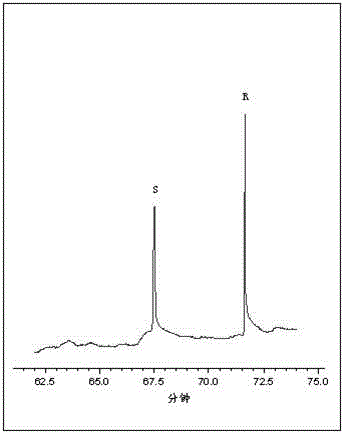Method for separating racemic 2-chloropropionic acid using capillary electrophoresis separation-diode array detection technology
A technology of capillary electrophoresis and diode array, which is applied in the direction of material analysis, measuring device and analysis material by electromagnetic means, can solve the problems of easy hydrolysis of the coating, toxic and side effects, and high cost, and achieves good separation, simple operation, and easy operation. easy effect
- Summary
- Abstract
- Description
- Claims
- Application Information
AI Technical Summary
Problems solved by technology
Method used
Image
Examples
Embodiment 1
[0030] (1) Preparation of buffer solution: adjust the phosphoric acid solution with a concentration of 150 mmol / L to pH 7.0 with 0.33 mol / L Tris buffer solution to obtain the final product;
[0031] (2) Preparation of electrophoresis running buffer solution: Add chiral resolving agent, organic solvent and cationic surfactant to the buffer solution prepared in step (1) respectively, and mix with ultrasonic to obtain capillary electrophoresis running buffer solution; Described chiral resolving agent is 2-HP-β-CD, and its concentration is 110 mmol / L in buffer solution; Described organic solvent is acetonitrile, and the volume fraction in buffer solution is 5%; Described cationic surface Active agent is CTAB, and its concentration in the buffer solution is 0.2 mmol / L;
[0032] (3) Standard stock solution of R / S-chloropropionic acid: prepare standard stock solutions of R-2-chloropropionic acid and S-2-chloropropionic acid with ultrapure water, the concentration is 30mmol / L, store i...
Embodiment 2
[0037] The concentration of the phosphoric acid solution in step (1) of Example 1 was replaced by 100 mmol / L, and adjusted to pH 6.0 with 0.2 mol / L Tris buffer;
[0038] Replace the chiral resolving agent in step (2) of Example 1 with β-cyclodextrin, whose concentration in the buffer solution is 25mmol / L; replace the organic solvent with methanol, and the volume fraction in the buffer solution is 3 %;
[0039] Replace the concentration of R-2-chloropropionic acid and S-2-chloropropionic acid standard stock solution prepared in step (3) of Example 1 with 20mmol / L;
[0040] The remaining steps are the same as in Example 1, and the retention time of R-2-chloropropionic acid and S-2-chloropropionic acid obtained is slightly different from that of Example 1. The separation degree of the two optical isomers in this example is 2.40.
Embodiment 3
[0042] The concentration of the phosphoric acid solution in step (1) of Example 1 was replaced by 130mmol / L, and adjusted to pH 8.0 with 0.4 mol / L Tris buffer;
[0043] Replace the chiral resolving agent in step (2) of Example 1 with β-cyclodextrin, whose concentration in the buffer solution is 25mmol / L; replace the organic solvent with absolute ethanol, the volume fraction in the buffer solution 10%;
[0044] Replace the concentration of R-2-chloropropionic acid and S-2-chloropropionic acid standard stock solution prepared in step (3) of Example 1 with 50mmol / L;
[0045] The remaining steps are the same as in Example 1, and the retention time of R-2-chloropropionic acid and S-2-chloropropionic acid is slightly different from that of Examples 1 and 2, and the degree of separation of the two optical isomers is 2.37.
[0046] Investigate enantiomeric separation retention time, peak area reproducibility, the results are as follows: 1. Standard deviation of retention time: S-2-ch...
PUM
| Property | Measurement | Unit |
|---|---|---|
| separation | aaaaa | aaaaa |
Abstract
Description
Claims
Application Information
 Login to View More
Login to View More - R&D
- Intellectual Property
- Life Sciences
- Materials
- Tech Scout
- Unparalleled Data Quality
- Higher Quality Content
- 60% Fewer Hallucinations
Browse by: Latest US Patents, China's latest patents, Technical Efficacy Thesaurus, Application Domain, Technology Topic, Popular Technical Reports.
© 2025 PatSnap. All rights reserved.Legal|Privacy policy|Modern Slavery Act Transparency Statement|Sitemap|About US| Contact US: help@patsnap.com

